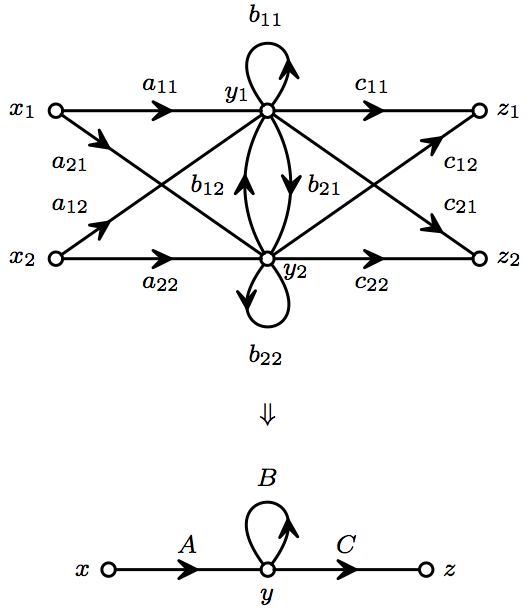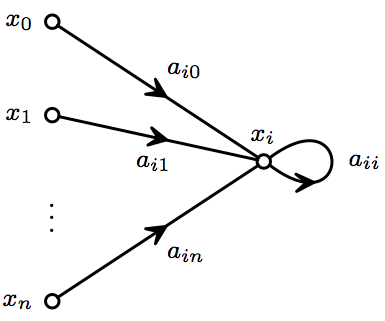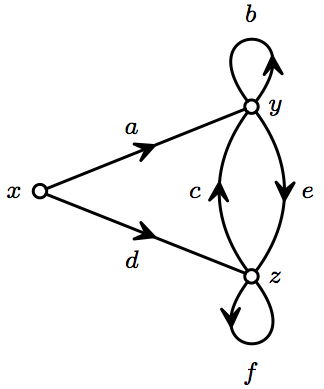Noncommutative Signal-flow Graph on:
[Wikipedia]
[Google]
[Amazon]
 In automata theory and
In automata theory and
 Consider ''n'' equations involving ''n''+1 variables .
:
with ''a''ij elements in a ring or semiring ''R''. The free variable ''x''0 corresponds to a source vertex ''v''0, thus having no defining equation. Each equation corresponds to a fragment of a directed graph ''G''=(''V'',''E'') as show in the figure.
The edge weights define a function ''f'' from ''E'' to ''R''. Finally fix an output vertex ''vm''. A signal-flow graph is the collection of this data ''S'' = (''G''=(''V'',''E''), ''v0'',''vm'' ''V'', ''f'' : ''E'' → ''R''). The equations may not have a solution, but when they do,
:
with ''T'' an element of ''R'' called the gain.
Consider ''n'' equations involving ''n''+1 variables .
:
with ''a''ij elements in a ring or semiring ''R''. The free variable ''x''0 corresponds to a source vertex ''v''0, thus having no defining equation. Each equation corresponds to a fragment of a directed graph ''G''=(''V'',''E'') as show in the figure.
The edge weights define a function ''f'' from ''E'' to ''R''. Finally fix an output vertex ''vm''. A signal-flow graph is the collection of this data ''S'' = (''G''=(''V'',''E''), ''v0'',''vm'' ''V'', ''f'' : ''E'' → ''R''). The equations may not have a solution, but when they do,
:
with ''T'' an element of ''R'' called the gain.
 Consider the
Consider the  Adding to ''Td'', the alternating product of node factors and path weights, we obtain two gain expressions:
:
and
:
These values are easily seen to be the same using identities (''ab'')−1 = ''b''−1''a''−1 and ''a''(1-''ba'')−1=(1-''ab'')−1''a''.
Adding to ''Td'', the alternating product of node factors and path weights, we obtain two gain expressions:
:
and
:
These values are easily seen to be the same using identities (''ab'')−1 = ''b''−1''a''−1 and ''a''(1-''ba'')−1=(1-''ab'')−1''a''.
 An important kind of noncommutative signal-flow graph is a finite state
An important kind of noncommutative signal-flow graph is a finite state
 In automata theory and
In automata theory and control theory
Control theory is a field of mathematics that deals with the control of dynamical systems in engineered processes and machines. The objective is to develop a model or algorithm governing the application of system inputs to drive the system to a ...
, branches of mathematics
Mathematics is an area of knowledge that includes the topics of numbers, formulas and related structures, shapes and the spaces in which they are contained, and quantities and their changes. These topics are represented in modern mathematics ...
, theoretical computer science
Theoretical computer science (TCS) is a subset of general computer science and mathematics that focuses on mathematical aspects of computer science such as the theory of computation, lambda calculus, and type theory.
It is difficult to circumsc ...
and systems engineering
Systems engineering is an interdisciplinary field of engineering and engineering management that focuses on how to design, integrate, and manage complex systems over their enterprise life cycle, life cycles. At its core, systems engineering util ...
, a noncommutative signal-flow graph is a tool for modeling interconnected systems and state machines by mapping the edges of a directed graph to a ring
Ring may refer to:
* Ring (jewellery), a round band, usually made of metal, worn as ornamental jewelry
* To make a sound with a bell, and the sound made by a bell
:(hence) to initiate a telephone connection
Arts, entertainment and media Film and ...
or semiring.
A single edge weight might represent an array of impulse response
In signal processing and control theory, the impulse response, or impulse response function (IRF), of a dynamic system is its output when presented with a brief input signal, called an Dirac delta function, impulse (). More generally, an impulse ...
s of a complex system (see figure to the right), or a character from an alphabet
An alphabet is a standardized set of basic written graphemes (called letters) that represent the phonemes of certain spoken languages. Not all writing systems represent language in this way; in a syllabary, each character represents a syll ...
picked off the input tape of a finite automaton, while the graph might represent the flow of information or state transitions.
As diverse as these applications are, they share much of the same underlying theory.
Definition
 Consider ''n'' equations involving ''n''+1 variables .
:
with ''a''ij elements in a ring or semiring ''R''. The free variable ''x''0 corresponds to a source vertex ''v''0, thus having no defining equation. Each equation corresponds to a fragment of a directed graph ''G''=(''V'',''E'') as show in the figure.
The edge weights define a function ''f'' from ''E'' to ''R''. Finally fix an output vertex ''vm''. A signal-flow graph is the collection of this data ''S'' = (''G''=(''V'',''E''), ''v0'',''vm'' ''V'', ''f'' : ''E'' → ''R''). The equations may not have a solution, but when they do,
:
with ''T'' an element of ''R'' called the gain.
Consider ''n'' equations involving ''n''+1 variables .
:
with ''a''ij elements in a ring or semiring ''R''. The free variable ''x''0 corresponds to a source vertex ''v''0, thus having no defining equation. Each equation corresponds to a fragment of a directed graph ''G''=(''V'',''E'') as show in the figure.
The edge weights define a function ''f'' from ''E'' to ''R''. Finally fix an output vertex ''vm''. A signal-flow graph is the collection of this data ''S'' = (''G''=(''V'',''E''), ''v0'',''vm'' ''V'', ''f'' : ''E'' → ''R''). The equations may not have a solution, but when they do,
:
with ''T'' an element of ''R'' called the gain.
Successive Elimination
Return Loop Method
There exist several noncommutative generalizations ofMason's rule Mason's gain formula (MGF) is a method for finding the transfer function of a linear signal-flow graph (SFG). The formula was derived by Samuel Jefferson Mason, whom it is also named after. MGF is an alternate method to finding the transfer functio ...
. The most common is the return loop method (sometimes called the forward return loop method (FRL), having a dual backward return loop method (BRL)). The first rigorous proof is attributed to Riegle, so it is sometimes called Riegle's rule.
As with Mason's rule Mason's gain formula (MGF) is a method for finding the transfer function of a linear signal-flow graph (SFG). The formula was derived by Samuel Jefferson Mason, whom it is also named after. MGF is an alternate method to finding the transfer functio ...
, these gain expressions combine terms in a graph-theoretic manner (loop-gains, path products, etc.). They are known to hold over an arbitrary noncommutative ring and over the semiring of regular expressions.
Formal Description
The method starts by enumerating all paths from input to output, indexed by ''j'' ''J''. We use the following definitions: * The ''j''-th path product is (by abuse of notation) a tuple of ''kj'' edge weights along it: :::: * To split a vertex ''v'' is to replace it with a source and sink respecting the original incidence and weights (this is the inverse of the graph morphism taking source and sink to ''v''). * Theloop gain
In electronics and control system theory, loop gain is the sum of the gain, expressed as a ratio or in decibels, around a feedback loop. Feedback loops are widely used in electronics in amplifiers and oscillators, and more generally in both elec ...
of a vertex ''v'' w.r.t. a subgraph ''H'' is the gain from source to sink of the signal-flow graph split at ''v'' after removing all vertices not in ''H''.
* Each path defines an ordering of vertices along it. The along path ''j'', the ''i''-th FRL (BRL) node factor is (1-''Si(j)'')−1 where ''Si(j)'' is the loop gain of the ''i''-th vertex along the ''j''-th w.r.t. the subgraph obtained by removing ''v''0 and all vertices ahead of (behind) it.
The contribution of the ''j''-th path to the gain is the product along the path, alternating between the path product weights
and the node factors:
:
so the total gain is
:
An Example
 Consider the
Consider the signal-flow graph
A signal-flow graph or signal-flowgraph (SFG), invented by Claude Shannon, but often called a Mason graph after Samuel Jefferson Mason who coined the term, is a specialized flow graph, a directed graph in which nodes represent system variables, ...
shown. From ''x'' to ''z'', there are two path products: (''d'') and (''e,a''). Along (''d''), the FRL and BRL contributions coincide as both share same loop gain (whose split reappears in the upper right of the table below):
:
Multiplying its node factor and path weight, its gain contribution is
:
Along path (''e,a''), FRL and BRL differ slightly, each having distinct splits of vertices ''y'' and ''z'' as shown in the following table.
: Adding to ''Td'', the alternating product of node factors and path weights, we obtain two gain expressions:
:
and
:
These values are easily seen to be the same using identities (''ab'')−1 = ''b''−1''a''−1 and ''a''(1-''ba'')−1=(1-''ab'')−1''a''.
Adding to ''Td'', the alternating product of node factors and path weights, we obtain two gain expressions:
:
and
:
These values are easily seen to be the same using identities (''ab'')−1 = ''b''−1''a''−1 and ''a''(1-''ba'')−1=(1-''ab'')−1''a''.
Applications
Matrix Signal-Flow Graphs
Consider equations : and : This system could be modeled as scalar signal-flow graph with multiple inputs and outputs. But, the variables naturally fall into layers, which can be collected into vectors ''x''=(''x''1,''x''2)''t'' ''y''=(''y''1,''y''2)''t'' and ''z''=(''z''1,''z''2)''t''. This results in much simpler matrix signal-flow graph as shown in the figure at the top of the article. Applying the forward return loop method is trivial as there's a single path product (''C'',''A'') with a single loop-gain ''B'' at ''y''. Thus as a matrix, this system has a very compact representation of its input-output map: :Finite Automata
 An important kind of noncommutative signal-flow graph is a finite state
An important kind of noncommutative signal-flow graph is a finite state automaton
An automaton (; plural: automata or automatons) is a relatively self-operating machine, or control mechanism designed to automatically follow a sequence of operations, or respond to predetermined instructions.Automaton – Definition and More ...
over an alphabet .
Serial connections correspond to the concatenation of words, which can be extended to subsets of the free monoid . For ''A'', ''B''
:
Parallel connections correspond to set union
In set theory, the union (denoted by ∪) of a collection of sets is the set of all elements in the collection. It is one of the fundamental operations through which sets can be combined and related to each other.
A refers to a union of ze ...
, which in this context is often written ''A''+''B''.
Finally, self-loops naturally correspond to the Kleene closure
In mathematical logic and computer science, the Kleene star (or Kleene operator or Kleene closure) is a unary operation, either on sets of strings or on sets of symbols or characters. In mathematics,
it is more commonly known as the free monoid ...
:
where is the empty word. The similarity to the infinite geometric series
:
is more than superficial, as expressions of this form serve as 'inversion' in this semiring.
In this way, the subsets of built of from finitely many of these three operations can be identified with the semiring of regular expressions. Similarly, finite graphs whose edges are weighted by subsets of can be identified with finite automata, though generally that theory starts with singleton sets as in the figure.
This automaton is deterministic so we can unambiguously enumerate paths via words. Using the return loop method, path contributions are:
* path ''ab'', has node factors (''c''*, ), yielding gain contribution
::
* path ''ada'', has node factors (''c''*, ''c''*, ), yielding gain contribution
::
* path ''ba'', has node factors (''c''*, ), yielding gain contribution
::
Thus the language
Language is a structured system of communication. The structure of a language is its grammar and the free components are its vocabulary. Languages are the primary means by which humans communicate, and may be conveyed through a variety of met ...
accepted by this automaton (the gain of its signal-flow graph) is the sum of these terms
:
Historical Notes
See also
*Signal-flow graph
A signal-flow graph or signal-flowgraph (SFG), invented by Claude Shannon, but often called a Mason graph after Samuel Jefferson Mason who coined the term, is a specialized flow graph, a directed graph in which nodes represent system variables, ...
*Mason's rule Mason's gain formula (MGF) is a method for finding the transfer function of a linear signal-flow graph (SFG). The formula was derived by Samuel Jefferson Mason, whom it is also named after. MGF is an alternate method to finding the transfer functio ...
* Finite automata
* Regular expressions
Notes
References
* * * * * * * *{{cite journal , last1=Riegle , first1=Daryle , last2=Lin , first2=P.M. , title=Matrix signal flow graphs and an optimum topological method for evaluating their gains , journal=IEEE Transactions on Circuit Theory , volume=19 , number=5 , pages=427–435 , year=1972 , publisher=IEEE , doi=10.1109/tct.1972.1083542 Control theory Automata (computation)